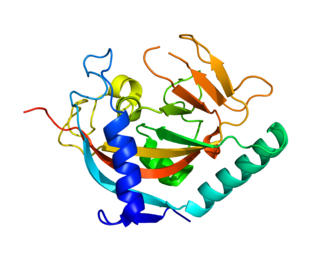Vacuolar protein sorting-associated protein 33A is a protein that in humans is encoded by the VPS33A gene. [4] [5]
Vacuolar protein sorting-associated protein 33A is a protein that in humans is encoded by the VPS33A gene. [4] [5]
Vesicle mediated protein sorting plays an important role in segregation of intracellular molecules into distinct organelles. Genetic studies in yeast have identified more than 40 vacuolar protein sorting (VPS) genes involved in vesicle transport to vacuoles. This gene is a member of the Sec-1 domain family, and it encodes a protein similar to the yeast class C Vps33 protein. The mammalian class C VPS proteins are predominantly associated with late endosomes/lysosomes, and like their yeast counterparts, may mediate vesicle trafficking steps in the endosome/lysosome pathway. [5]
A syndrome has been described that appears to be associated with mutations in this gene. [7] This syndrome has since been named Mucopolysaccharidosis-plus syndrome. [8]
Retromer is a complex of proteins that has been shown to be important in recycling transmembrane receptors from endosomes to the trans-Golgi network (TGN).

Tumor susceptibility gene 101, also known as TSG101, is a human gene that encodes for a cellular protein of the same name.
BLOC-1 or biogenesis of lysosome-related organelles complex 1 is a ubiquitously expressed multisubunit protein complex in a group of complexes that also includes BLOC-2 and BLOC-3. BLOC-1 is required for normal biogenesis of specialized organelles of the endosomal-lysosomal system, such as melanosomes and platelet dense granules. These organelles are called LROs which are apparent in specific cell-types, such as melanocytes. The importance of BLOC-1 in membrane trafficking appears to extend beyond such LROs, as it has demonstrated roles in normal protein-sorting, normal membrane biogenesis, as well as vesicular trafficking. Thus, BLOC-1 is multi-purposed, with adaptable function depending on both organism and cell-type.

Synaptobrevin-like protein 1 (SYBL1), also known as Vesicle-associated membrane protein 7 (VAMP7), is a protein that in humans is encoded by the VAMP7, or SYBL1, gene.

Syntaxin-7 is a protein that in humans is encoded by the STX7 gene.

Syntaxin-6 is a protein that in humans is encoded by the STX6 gene.

Tankyrase, also known as tankyrase 1, is an enzyme that in humans is encoded by the TNKS gene. It inhibits the binding of TERF1 to telomeric DNA.

Vacuolar protein sorting-associated protein 35 is a protein that in humans is encoded by the VPS35 gene.

Vacuolar protein sorting-associated protein 4A is a protein that in humans is encoded by the VPS4A gene.

Vacuolar protein sorting-associated protein 4B is a protein that in humans is encoded by the VPS4B gene.

Syntaxin-8 is a protein that in humans is encoded by the STX8 gene. Syntaxin 8 directly interacts with HECTd3 and has similar subcellular localization. The protein has been shown to form the SNARE complex with syntaxin 7, vti1b and endobrevin. These function as the machinery for the homotypic fusion of late endosomes.

Vacuolar protein sorting-associated protein 26A is a protein that in humans is encoded by the VPS26A gene.

VPS29 is a human gene coding for the vacuolar protein sorting protein Vps29, a component of the retromer complex.

Vacuolar protein sorting-associated protein 45 is a protein that in humans is encoded by the VPS45 gene.

Vacuolar protein sorting-associated protein 33B is a protein that in humans is encoded by the VPS33B gene.

Vacuolar protein sorting-associated protein 11 homolog is a protein that in humans is encoded by the VPS11 gene.

Vacuolar protein sorting-associated protein 18 homolog is a protein that in humans is encoded by the VPS18 gene.

Vacuolar protein sorting-associated protein 52 homolog is a protein that in humans is encoded by the VPS52 gene.

Vacuolar protein-sorting-associated protein 25 is a protein that in humans is encoded by the VPS25 gene.

Vacuolar protein sorting 53 homolog is a protein that in humans is encoded by the VPS53 gene.
| This article on a gene on human chromosome 12 is a stub. You can help Wikipedia by expanding it. |